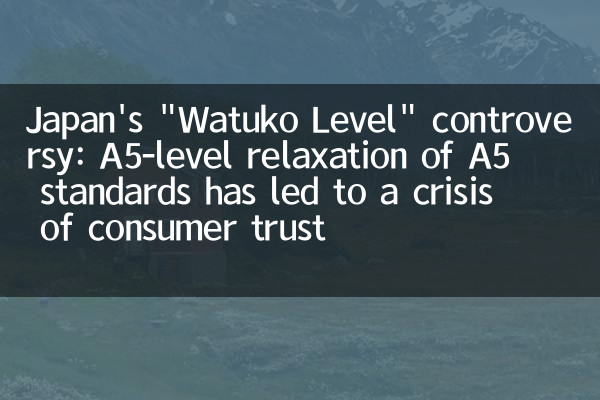Japan's "Watuko Level" controversy: A5-level relaxation of A5 standards has led to a crisis of consumer trust
Recently, the adjustment of Japanese Wagyu rating standards has caused widespread controversy. According to Japanese media reports, the Japanese Carnivore Association (JMGA) has quietly relaxed the evaluation standards for A5 Wagyu beef, resulting in a surge in the number of "A5" Wagyu beefs in the market and a sharp decline in consumer trust in the rating system. This change not only affected the consumer confidence in Japan's domestic market, but also had an impact on the export market.
1. Controversy background: A5 Wagyu Standards are relaxed

Wagyu is the most representative high-end beef in Japan, and its rating is rated by"Step Level" (A~C)and"Feature Grade" (1~5)Two parts are composed of. Level A5 is the highest grade, which means that the fat is evenly distributed and the flesh is delicate. However, recently, JMGA has been revealed to have adjusted the A5 level assessment criteria, especially for"Fat Hybrid (BMS)"The rating requirements have been reduced, resulting in more beef being classified as A5.
| Rating items | Original standard (BMS value) | Adjusted standard (BMS value) |
|---|---|---|
| Level A5 (highest level) | 8~12 | 7~12 |
| Level A4 | 5~7 | 4~7 |
2. Market reaction: The crisis of consumer trust intensifies
After the relaxation of standards, the supply of A5-level wagyu cattle has increased significantly. Data shows that the market share of A5 Wagyu beef in October 2023 increased from 35% last year to 52%, but consumers generally reported that "quality is uneven." Here are the survey results of major consumer cities in Japan:
| City | Reduced trust in A5 level | Changes in purchasing volume of high-end restaurants |
|---|---|---|
| Tokyo | 68% | -15% |
| Osaka | 72% | -18% |
| Fukuoka | 61% | -12% |
3. Industry impact: Export market is impacted
Japanese Wagyu beef exports exceed 50 billion yen per year, of which A5-level accounts for more than 70%. After the standards were relaxed, overseas buyers began to require third-party inspection reports. Here are the reactions from major export markets in the past three months:
| Export area | Changes in order quantity | Price fluctuations |
|---|---|---|
| Chinese mainland | -twenty two% | -8% |
| USA | -15% | -5% |
| Hongkong | -18% | -7% |
4. Expert opinion: The rating system needs to be transparent
Kenichi Yamada, professor of agricultural economics at the University of Tokyo, pointed out: "Wagua grade is the golden signboard of Japanese food culture, and the changes in standards should be publicly demonstrated." The Japanese Consumer Agency has asked JMGA to submit an explanatory report and the investigation results are expected to be announced at the end of November.
5. Future Outlook: Industry Self-Discipline may become the key
Some ranchers launched the "Real A5 Declaration" alliance, promising to maintain the original standard production. Analysts believe that the market may naturally differentiate into two categories of products, "traditional A5" and "new standard A5", and the price gap may further widen.
This dispute exposed the management loopholes in the agricultural product rating system. How to balance industrial development with consumer trust will become an important issue facing the Japanese Wagyu industry.

check the details

check the details